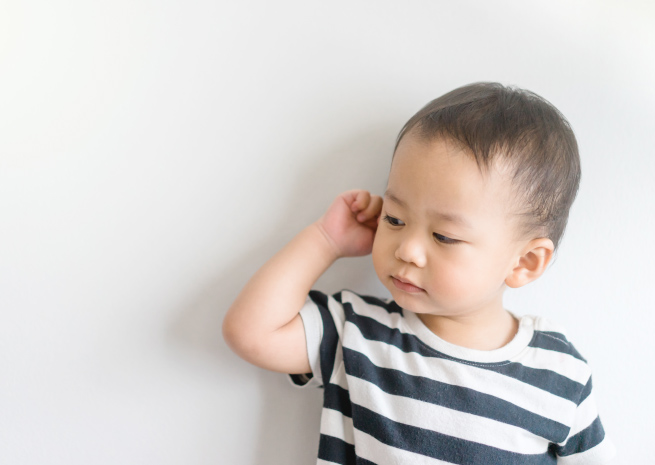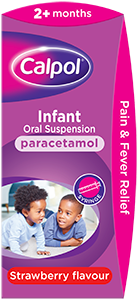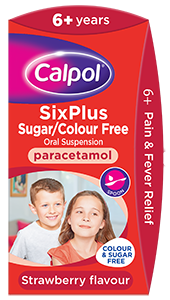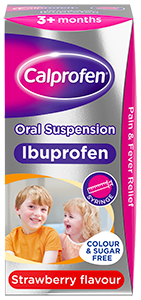Our dedicated earache page will look at:
Symptoms of earache
Symptoms of earache
Dr Ellie Canon says:
Learn more
Symptoms of earache
Symptoms of earache
Dr Ellie Canon says:
“Ear pain in children (earache) is a symptom of a number of different causes, but is often the result of an ear infection. Ear infections are categorised in two different ways: those that occur in the outer ear, and those which occur in the middle ear (behind the eardrum).”
“There is more than one type of ear pain which your little one may experience. Earache can be constant or come and go. It can also be sharp, dull or a burning sensation in one or both ears. There are a number of common symptoms relating to ear infection. These are:
- Dulled hearing, often lasting for a few days
- A fever
- Feelings of sickness, or vomiting
- Irritability (particularly in babies who cannot point to their pain)
With some infections, a child’s ear drum can also burst. If this is the case, there will often be ear discharge in the form of water and infected mucus. This will usually be runny for a few days. A burst eardrum often relieves the pain that your child has been feeling. This usually heals within a few weeks, after the infection has fully cleared.”
This content was written by healthcare professional Dr Ellie Canon in 2015. She was paid for her time but does not endorse CALPOL® Products.
How long will it last?
Most earaches will clear up on their own once the underlying cause goes away. How long it lasts can depend on the cause.
Close
Causes of earache
Causes of earache
Dr Ellie Canon says:
“Whilst there are a number of different causes, here are some of the most common causes of earache in children:
Learn more
Causes of earache
Causes of earache
Dr Ellie Canon says:
“Whilst there are a number of different causes, here are some of the most common causes of earache in children:
- Ear canal infection (the outer side of the eardrum)
- Glue ear (a build-up of fluid in the middle ear)
- Earwax, or another object, stuck inside the ear
- Damage caused to the inside of the ear (such as a scrape caused by a cotton bud)
- A throat infection (such as tonsillitis or quinsy)
It is also common for children to get a build-up of mucus in their middle ear after a cold. This will often clear on its own within a few days. Pain from other areas of the body can also sometimes appear as ear pain, such as problems with teeth and teething.”
This content was written by healthcare professional Dr Ellie Canon in 2015. She was paid for her time but does not endorse CALPOL® Products.
Close
What is Glue Ear?
What is Glue Ear?
Dr Ellie Canon says:
Learn more
What is Glue Ear?
What is Glue Ear?
Dr Ellie Canon says:
Glue ear is a build-up of sticky fluid in the middle ear. This prevents parts of the middle ear from moving freely, which results in mild to moderate hearing loss. The middle ear is right behind the eardrum and is made up of three tiny bones that carry sound vibrations from the eardrum to the inner ear. The build-up of fluid that causes glue ear prevents the passing of sound vibrations. Glue ear is also known as ‘otitis media with effusion’ (OME).
Glue ear can cause minor temporary delays in speech and development in younger children as a result of the hearing loss. However, some of the problems associated with glue ear tend to get better by themselves in a short period of time.”
This content was written by healthcare professional Dr Ellie Canon in 2015. She was paid for her time but does not endorse CALPOL® Products.
How common is glue ear in children?
Glue ear is a very common condition in children, particularly between 2-5 years of age. Because some children develop glue ear following a cold, it tends to be more common in the winter months. Around 8 out of 10 children will have experienced glue ear at least once before they reach their 10th birthday.
Dr Ellie Canon says:
“It is important to see your family doctor if you are concerned that your little one may have glue ear. If your GP also suspects glue ear, they will look inside your child’s ear using a medical instrument called an otoscope. This is not a painful procedure and it will allow your doctor to look for some of the tell-tale signs of glue ear, such as the eardrum looking dull or cloudy, or visible fluid behind it.
This content was written by healthcare professional Dr Ellie Canon in 2015. She was paid for her time but does not endorse CALPOL® Products.
Close
Treatments of earache
Treatments of earache
Often earaches are caused by an ear infection, which will generally take a few days to clear up. You can soothe your child’s pain with infant paracetamol or ibuprofen.
Do they have a fever too?
Learn more
Treatments of earache
Treatments of earache
Often earaches are caused by an ear infection, which will generally take a few days to clear up. You can soothe your child’s pain with infant paracetamol or ibuprofen.
Do they have a fever too?
Paracetamol and Ibuprofen-based medicines can help to treat pain as well as reduce a fever. CALPOL® Infant Suspension, CALPOL® SIXPLUS™ Suspension and CALPROFEN® Ibuprofen Suspension get to work on fever in just 15 minutes.
Are they 6 years or older?
For pain and fever, CALPOL® SIXPLUS™ Suspension can be used for children over 6 years old.
What are the treatment options for children with ear problems?
Dr Ellie Canon says:
“The treatment that your child requires depends on the particular ear problem that they have.
Many outer ear infections clear up on their own without specific medication, but in some cases antibiotic treatment, in the form of tablets or eardrops, can be prescribed for bacterial infections. If your child has a boil (a hair follicle that has become infected) inside their ear, this will also often burst and heal itself within a few days.
Earache that is the result of damage to the ear, such as excessive cotton bud use, or poking the cotton bud too far into the ear so that it bursts the eardrum, does not often require medication. The sensitive and damaged area of the ear should heal on its own without treatment, although if the eardrum is burst this can take a few weeks to heal. For most types of ear infection, general over the counter medicines such as paracetamol and ibuprofen can lower a child’s fever and provide pain relief to help them manage the symptoms of an ear infection.
A plug of hard earwax can also cause earache. If this is the case with your little one, it is important that you do not try and remove this yourself with a cotton bud. This can push the wax further inside, and may also burst the eardrum. Your doctor or pharmacist will be able to recommend an eardrop that will soften the wax in your child’s ear to help it fall out naturally.
If your child has earache and also finds it painful to swallow, they may also have tonsillitis or an abscess on the back of their throat. This is known as quinsy. Quinsy is a rare complication of tonsillitis that must be diagnosed and treated quickly to prevent the infection from spreading elsewhere in your child’s body and to prevent any possible breathing difficulties.
The majority of tonsillitis cases will clear up on their own without any medical treatment. However, bacterial tonsillitis may require a course of oral antibiotics after a diagnosis has been made.”
This content was written by healthcare professional Dr Ellie Canon in 2015. She was paid for her time but does not endorse CALPOL® Products.
Close
Treatment for glue ear
Treatment for glue ear
Dr Ellie Canon says:
Learn more
Treatment for glue ear
Treatment for glue ear
Dr Ellie Canon says:
"Many doctors will not consider any treatment for glue ear unless it persists for a long time. This is because around half of all cases will get better without medical treatment within 3 months, and around 90% of all cases will get better on their own within a year.”
This content was written by healthcare professional Dr Ellie Canon in 2015. She was paid for her time but does not endorse CALPOL® Products.
Close
When to call the doctor
When to call the doctor
Ear infections are very common, and they’ll generally clear up without any trouble. But you should get in touch with your GP if your child has had earache for more than 3 days or if they keep getting earache. Get an urgent GP appointment if:
Learn more
When to call the doctor
When to call the doctor
Ear infections are very common, and they’ll generally clear up without any trouble. But you should get in touch with your GP if your child has had earache for more than 3 days or if they keep getting earache. Get an urgent GP appointment if:
- become generally unwell
- a very high temperature or feel hot and shivery
- swelling around the ear
- fluid coming from the ear
- hearing loss or a change in hearing
- something stuck in the ear
- your child is under 2 and has earache in both ears
The information on this page is not exhaustive. You know your child best, if you have any concerns about your child, you should contact your GP.
Close
- For mild earache, you can try gently placing a warm flannel over the affected ear (it may soothe them if you whisper a few gentle words in it too!).
- Avoid getting the affected ear wet
- Make sure you don’t put cotton buds into your little one’s ear as the ear canal is very delicate.
- If your little one’s eardrums burst, make sure you do not put anything in their ear unless recommended by the doctor. This includes eardrops and cotton buds.





Dr Ellie Cannon is a practicing NHS GP, and works on public health campaigns including childhood health programmes. She is a mum of two, and has written a popular book on parenting 'Keep Calm, The New Mum's manual', which considers the physical and mental health of parents alongside baby care.
This HCP does not endorse Calpol.